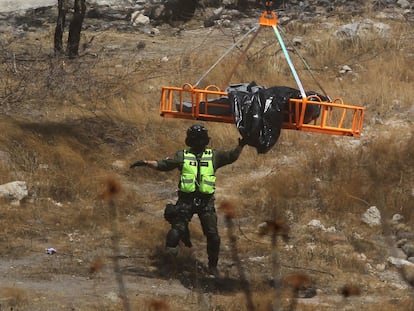The ‘Lagos de Moreno case’: The kidnapping of five young people in Jalisco and the video that destroyed everything
The disappearance of the young men from the city of Lagos de Moreno highlights the resurgence of violence in a besieged country

At the doors of the Prosecutor’s Office in the Mexican state of Jalisco, there’s a live broadcast by local media. In the middle of the night, the recording captures the sound of a terrible scream.
The families of Roberto Olmeda, Diego Lara, Uriel Galván, Jaime Martínez and Dante Cedillo have received a photograph and a video of the kidnapped boys. Since August 11, the fathers, mothers, brothers and friends of the young men had been waiting to hear any news about their missing loved ones. On the night of Tuesday, August 15, they were recognized in a video, which depicted their murders. Behind that scream was the hidden pain of a besieged country.
A week ago, the boys from the city of Lagos de Moreno met at the San Miguel lookout point. Roberto, Diego, Uriel, Jaime and Dante were between the ages of 19 and 22. Friends since childhood, their lives had taken different paths: Roberto was studying engineering, Diego was a blacksmith, Jaime a bricklayer, while Dante had started his own business. Still, they frequently spent evenings together in their neighborhood.
It was Magalli Lara – Diego’s sister – who sounded the alarm about the disappearance of the boys: “Urgent: since last night, our lives have been plunged into anguish,” the young woman wrote on social media. From the outset, the families organized protests, demanding that the authorities make progress in the search.
The case could have remained in the atrocious limbo that more than 110,000 families in Mexico are currently living through: searching for their disappeared, digging the ground and searching graves to find clues. In the state of Jalisco alone, there are 14,890 missing people. According to official government figures, it’s the state with the highest number of missing persons.
Three weeks ago, less than 25 miles from Lagos, in Encarnación de Díaz, the Saucedo Zermeño sisters were abducted. Adriana, Olivia and her partner Beatriz Hernández disappeared when they were in their car, on July 27. Marisela was taken from her home by armed men the next day. At 28-years-old, she was the oldest of the girls. There is still no trace of them. And, for days, none of the authorities were even searching for them. EL PAÍS has repeatedly asked the Jalisco Prosecutor’s Office about the progress in the search. “Actions are being carried out in the office and in the field” is the standard reply.
Horror has engulfed the case of the five young men from Lagos de Moreno. The dissemination of an image – in which the boys appear tied up and beaten, but alive – was proof that organized crime had taken them. In the northern part of the state, the law of the drug lords prevails. In the absence of state intervention, the Sinaloa Cartel and the Jalisco Cartel wage a bloody dispute for control over the area. The renowned anthropologist Rossana Reguillo calls this the era of the “necromachine – a death machine that doesn’t mind swallowing bodies, territories, and then vomiting them up in the form of graves, corpses.”
The subsequent evidence that the families received went beyond any sense of sanity. A video shows two of the boys lying on the ground, covered in blood, while in the background – in a horrific scene – one of the boys is being forced to kill one of his friends. This vertical recording lasts just over a minute – it’s where everything ends. “The video is a message of terror. It wasn’t leaked; it was circulated with the full intention of sending messages, probably to an opposing group and to the citizens, who remain terrified,” Reguillo points out. “It [conveys] something very deep, very broken and very decomposed. Involving the victims in this bloody scenario is terrifying – I think it also marks a turning point.”
The video encompasses everything that a country with more than 15 years of latent war has had to face: the constant resurgence of violence, the spectacularization of pain and the impact on a generation of young people, who, whenever they leave their families, don’t know if they will come back. The images are played before the eyes of a petrified state.
“What the case of Lagos lets us see – which is just the tip of the iceberg – is that what we’re experiencing transcends the numbers [related to] the violence,” says Leonel Fernández, a member of Mexico’s National Citizen Observatory. “We have to think beyond sterile numbers. The magnitude is overwhelming: it’s no longer a matter of economic kidnapping or warfare between groups. That the Lagos [kidnappings and murders] can occur so openly, as if nothing had happened, illustrates the defenselessness of Mexicans, the weakness of the state. What this has exposed is that there’s no capacity to resolve this type of violence: our authorities don’t know where to start [in the fight] against this absolute violence, where the strongest wins.”
This isn’t the first time that raw pain has ripped through Lagos de Moreno. Back in 2013, the disappearance of seven people – six youngsters and one adult – was reported. A few days later, some of their remains were found in an old grocery store, on the outskirts of the municipality, which organized criminal groups had turned into a safehouse. There was no video or photographs… in fact, there was hardly anything to identify the bodies. The relatives decided to convert the macabre place into a memorial, to mourn their dead.
“Violence has returned, in a different way, to emphasize that this entire area of Jalisco –which borders Guanajuato – has been turned into an extermination camp. There’s evidence that this barbarity didn’t start this year: it has been a growing process, one that I call ‘expressive violence.’ It no longer seeks an end, but rather seeks to exhibit the traces of its total power,” reflects the anthropologist Rossana Reguillo, from Jalisco.
This past April, one of the senior police officers in Encarnación de Díaz – next to Lagos, where the sisters disappeared – suffered an attack that was caught on camera. In May, four agents from the Prosecutor’s Office were ambushed and murdered in Tlajomulco, as they were on their way to search for the remains of the disappeared. Then, in June, some of the remains of eight young people – who were kidnapped from a call center in Zapopan – were found.
“The search for new methods of violence is worrying. There’s an escalation [with the intent] to exert control and maintain dominance,” says researcher Miguel Moctezuma, who studies violence. He points out changes in the state, such as the constant discovery of new clandestine fentanyl laboratories, or the seizure of new weapons used by organized crime.
Given this scenario, what can young people do, after knowing that a group of friends can go out one afternoon in a car and never return? Leonel Fernández points to the lack of opportunities for the vast majority of young people, who live in contexts where violence is daily and where forced recruitment and kidnapping for slave labor are common. The researcher highlights the responsibility of the government in creating strategies to “rescue these young people and break these gateways to violence.”
Reguillo – who has spent decades studying the impact of violence on youth – paints an accurate picture. “Today, our young people in Mexico are… besieged by violence and exclusion, which cannot be resolved with scholarships, nor with hugs, nor with bullets. The state – as a political figure – has been retreating, while another force tries to take its place. In urban youth – who, from 2011 to 2015 had a very strong [civic] participation – I now see a lack of will to fight, I see a very paralyzing sadness,” she points out, remembering the young people of Lagos and appealing to her fellow citizens: “I don’t know what we’re waiting for; it’s time to go out into the streets and protest.”
Sign up for our weekly newsletter to get more English-language news coverage from EL PAÍS USA Edition
Tu suscripción se está usando en otro dispositivo
¿Quieres añadir otro usuario a tu suscripción?
Si continúas leyendo en este dispositivo, no se podrá leer en el otro.
FlechaTu suscripción se está usando en otro dispositivo y solo puedes acceder a EL PAÍS desde un dispositivo a la vez.
Si quieres compartir tu cuenta, cambia tu suscripción a la modalidad Premium, así podrás añadir otro usuario. Cada uno accederá con su propia cuenta de email, lo que os permitirá personalizar vuestra experiencia en EL PAÍS.
¿Tienes una suscripción de empresa? Accede aquí para contratar más cuentas.
En el caso de no saber quién está usando tu cuenta, te recomendamos cambiar tu contraseña aquí.
Si decides continuar compartiendo tu cuenta, este mensaje se mostrará en tu dispositivo y en el de la otra persona que está usando tu cuenta de forma indefinida, afectando a tu experiencia de lectura. Puedes consultar aquí los términos y condiciones de la suscripción digital.
More information
Archived In
Últimas noticias
Most viewed
- David King, chemist: ‘There are scientists studying how to cool the planet; nobody should stop these experiments from happening’
- Reinhard Genzel, Nobel laureate in physics: ‘One-minute videos will never give you the truth’
- Mexico completes its trade shift with the entry into force of tariffs on China and countries without trade agreements
- Oona Chaplin: ‘I told James Cameron that I was living in a treehouse and starting a permaculture project with a friend’
- Sinaloa Cartel war is taking its toll on Los Chapitos










































